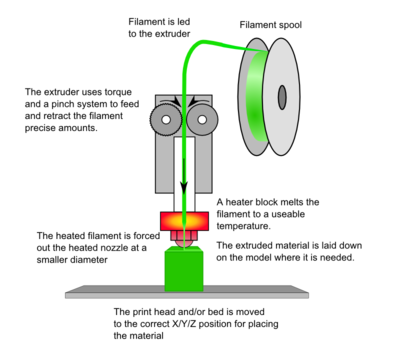FDM works by depositing droplets of melted thermoplastic in a computer controlled pattern much like a regular desktop printer jets ink.. The plastic solidifies after it is deposited to form one layer of a 3D object. When each layer is finished, the print head or print table are moved to allow the next layer to be added. This process is repeated layer after layer until the 3D item is completed.
The raw material for an FDM printer is typically a coil of plastic filament which is fed into a heating block to heat the end of the filament to the melting temperature. Stepper motors or servo motors move the print head to the precise x, y and z position to extrude each droplet.
 |
| Diagram from RepRap Wiki |
Stratasys manufactures a wide range of FDM machines from desktop models for designers to large industrial models for manufacturing plants. Stratasys has a trademark on the term Fused Deposition Modeling and the abbreviation FDM so the RepRap, Makerbot and most other small 3D printers which use the same process refer to it as Fused Filament Fabrication or FFF.
The FDM process works with several types of thermoplastics including acrylonitrile butadiene styrene (ABS) polymer, polycarbonates, polycaprolactone, polyphenylsulfones and waxes making it suitable for a wide variety of prototyping and manufacturing applications.
You Might Also Like:
3D Printing Crosses an Inflection Point
Additive Manufacturing Pioneers
It Started with Stereolithography
No comments:
Post a Comment